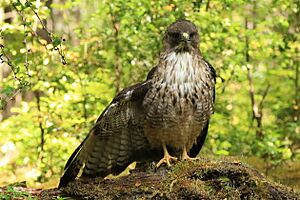Rufous-tailed hawk facts for kids
Quick facts for kids Rufous-tailed hawk |
|
|---|---|
 |
|
| Buteo ventralis in Aysén, Chile | |
| Conservation status | |
| Scientific classification | |
| Genus: |
Buteo
|
| Species: |
ventralis
|
 |
|
The rufous-tailed hawk (scientific name: Buteo ventralis) is a type of bird of prey. It belongs to the Accipitridae family, which includes many hawks and eagles.
You can find these hawks in southern Argentina and Chile. This includes the area called Tierra del Fuego. They live in places like cool forests and dry, warm areas with shrubland. They also live in high-up shrubland and grassy areas.
Contents
All About the Rufous-Tailed Hawk
The rufous-tailed hawk looks a lot like the red-tailed hawk. The famous scientist Charles Darwin first wrote about this bird. He saw it in Patagonia during his journey on the ship Beagle.
What Does a Rufous-Tailed Hawk Look Like?
This hawk is a medium-sized bird. Its wings can spread out about 45 to 60 centimeters wide. From head to tail, it measures about 54 to 60 centimeters long.
Rufous-tailed hawks come in two main colors. The most common one is pale. It has dark brownish-black feathers on its back. Its head is darker, and it has reddish-brown feathers on its neck and sides of its head. Its belly is white with dark marks and some reddish-brown color.
The other color is a dark version. These hawks are mostly black. Their feathers have whitish edges. The sound a rufous-tailed hawk makes is like kee-ahrr.
Where Rufous-Tailed Hawks Live
Rufous-tailed hawks live in many different places. They can be found in evergreen forests with beech trees. They also live in old, grown-up forests and new forests that have been burned. Sometimes, they are seen in open, grassy areas too.
Scientists believe their perfect home has tall trees. These trees are usually close to open spaces. This setup is great for hunting food. So far, no rufous-tailed hawks have been seen living near people. They don't live in cities or empty buildings.
What Rufous-Tailed Hawks Eat
Rufous-tailed hawks eat many different kinds of animals. Their diet is very broad, just like the red-tailed hawk. They eat other birds, small mammals, and even reptiles.
Scientists have seen them eating several things. These include southern lapwings (a type of bird) and Norwegian rats. They also eat European hares, red-breasted meadowlarks, and Chilean flickers. Sometimes, they even catch short-tailed snakes and different kinds of beetles. They hunt for food both in forests and in open grasslands.
Reproduction and Life Cycle
Rufous-tailed hawks spend more time raising their young in the nest. This is longer than some other types of Buteo hawks. Both rufous-tailed and red-tailed hawks have similar nestling periods. Rufous-tailed hawks stay in the nest for about 49 days. Red-tailed hawks stay for about 45 to 46 days.
A female rufous-tailed hawk usually lays 1 to 3 eggs in her nest.
Threats to Rufous-Tailed Hawks
Rufous-tailed hawks face many dangers. Losing their homes is a big problem. Their habitat is shrinking because of several things.
One reason is logging, which means cutting down trees. Another is too much grazing by sheep and cattle. Also, new farms of Pinus and Eucalyptus trees are growing. These trees grow very fast and were brought to Chile for the wood industry. They take over the hawks' natural homes.
Another threat comes from local people. Sometimes, people kill these hawks. This happens because the hawks might hunt and eat their farm animals.
How Many Rufous-Tailed Hawks Are There?
In 2001, scientists thought there were only about 100 rufous-tailed hawks. At that time, they were considered "low risk." But in 2015, their status changed to "vulnerable." This means they are at a higher risk of becoming endangered.
In 2015, scientists estimated there were about 299 to 999 adult hawks. The total number of all hawks was thought to be around 375 to 1499. If the total number of these hawks drops below 1000, they will be called "endangered." This means they would be in even greater danger. Scientists still need to count them more accurately. This will help us understand how much danger the rufous-tailed hawk is truly in.


